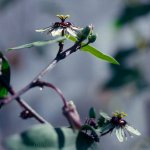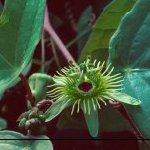| |
Passiflora Supersect. Cieca
Passiflora Supersect. Cieca (Medic.) J. M. MacDougal & Feuillet. Passiflora 13(2): 37. 2003 [2004]. Basionym:
Cieca Medic. Malvenfam. 97. 1787.

A selection of flowers from supersection Cieca, all presumed to be pollinated by small insects except P. viridiflora, which is pollinated by hummingbirds.
Photo: J.M. MacDougal
|

A selection of insect-pollinated flowers from species of supersection Cieca showing
absence of petals and variation in corona.
Photo: J.M. MacDougal
|
Small to medium-sized climbing or procumbent vines with annual or perennial stems
from woody perennial rootstocks or taproots, antrorsely appressed puberulent more or less
throughout, with unicellular, curved or occasionally erect trichomes, and sometimes sparsely
to densely pubescent with longer unicellular, rarely multicellular, curved trichomes.
Stems terete to somewhat compressed and two-edged, the shoot apex erect. Leaves simple,
commonly bearing nectaries on the petiole (except in P. eglandulosa and
P. mcvaughiana); petioles sometimes canaliculate, biglandular (rarely
eglandular or with only a single gland) with opposite, subopposite or alternate, discoid,
cupulate, obconical or capitate extrafloral nectaries; laminas unlobed or 2- to 3-lobed
(rarely 5-lobed), often exhibiting heterophylly, sometimes cordate at base, entire (very
rarely crenate), venation pinnate or usually palmate, variegated or not, peltate or not,
sometimes bearing small abaxial disciform or crateriform nectaries present ±
submarginally between the major veins (very rarely associated with leaf crenations).
Stipules setaceous to foliaceous, persistent, narrowly to widely ovate, rarely oblong or
obovate, symmetrical or sometimes asymmetrical, entire, not glandular. Tendrils simple,
lacking adhesive disks, straight or slightly curved during development at shoot apex.
Inflorescences sessile in leaf axils, the pedicels solitary or paired, collateral with
tendril, articulate, the articulation generally several mm below the flower; secondary
inflorescences sometimes present as condensed axillary or usually terminal shoots,
determinate or usually indeterminate; bracts 1 or 2 or lacking, narrowly ovate to entire.
Flowers erect or rarely ± horizontal, greenish yellow sometimes with purplish to
reddish markings, or red, hypanthium usually shallow, occasionally the calyx basally
connate into a conspicuous floral tube; sepals ovate-triangular, not corniculate, greenish
yellow or red; petals absent; coronal filaments in 2 series (rarely 1 or 7 series),
greenish yellow, sometimes with yellow and/or purple to red markings, or purple to red,
linear, often subcylindrical in cross-section, inner filaments usually capitate;
operculum connate, membranous, plicate (very rarely denticulate), incurved or rarely
semierect and laying against androgynophore; nectary trough-shaped or rarely absent,
commonly lacking a low annular ridge (nectar ring); limen adnate to floor of hypanthium
or rarely absent (in P. viridiflora the limen present as a shallow cup around
base of androgynophore), recurved or sometimes erect to inclined toward operculum.
Staminal filaments with the free portions actinomorphic; anthers extrorse at anthesis with
their axes maintained parallel to the filament or rarely only moving slightly from the
original introrse position to dehisce distally (upwards); pollen ellipsoid to spherical,
6-syncolporate. Ovary ellipsoid or globose, rarely slightly ovoid, obovoid or fusiform,
glabrous or rarely densely pubescent with curved, unicellular or rarely multicellular
trichomes; styles slender, less than 1.5 mm in diameter; stigmas capitate, depressed-ovoid.
Fruit a few to many-seeded purple or very dark purple berry, arils pale-translucent
covering approximately 3/4 of the seed. Seeds more or less compressed, often beaked at
chalazal apex, reticulate-foveate. Germination epigeal. Chromosome numbers: n=6 (12, 18).
Commonly lacking C-glycosylflavones and usually containing flavonol 3-O-glycosides.
Supersection Cieca is a monophyletic group of herbaceous to woody
climbers found in subtropical and tropical regions of the world from latitude 34°N to
latitude 34°S. The 19 species recognized here (three still undescribed) are primarily
distributed in the southern United States, Mexico, Central America, South America, and the
Caribbean. Two species, P. suberosa L. and P. pallida L.,
also occur in various regions of the Old World, likely as a result of naturalization.
Supersection Cieca belongs within subgenus Decaloba on the basis of
having flowers with the corona in a few series, a plicate operculum, secondary opercula on
the pollen grains, and a base chromosome number of six. The species of the supersection are
easily recognized by their small, apetalous, usually greenish flowers with the filaments of
the corona mostly in two series. Several factors enhance the biological significance of
Passiflora supersection Cieca. Of the four pollination syndromes commonly
reported for Passiflora, supersection Cieca exhibits three: melittophily
(pollination by bees), sphecophily (pollination by wasps), and ornithophily (pollination by
birds). The species of the supersection are also utilized as larval hosts by both primitive
and advanced genera of the subfamily Heliconiinae (Agraulis, Dione, Dryandula, Dryas,
Euptoieta, Heliconius, and Philaethria). Four of the 16 named species are listed as
endangered or threatened in the 1997 IUCN Red List of Threatened Plants. One species, P.
clypeophylla Mast., may be extinct and is represented by only a single herbarium
specimen. The status of another species, P. macfadyenii C.D. Adams, is uncertain,
because it has not been found in its native habitat in Jamaica since 1998.
| Included species |
Distribution |
Silicagel |
DNA isolated |
# genes sequenced |
| Passiflora clypeophylla |
Guatemala |
No |
No |
0 |
| Passiflora coriacea |
Bolivia, Colombia, Ecuador, Peru, Venezuela, Guyana? |
Yes |
Yes |
5 |
| Passiflora eglandulosa |
Guatemala, Honduras, El Salvador |
No |
No |
0 |
| Passiflora juliana |
Mexico |
Yes |
Yes |
4 |
| Passiflora lancifolia |
Jamaica |
Yes |
Yes |
2 |
| Passiflora macfadyenii |
Jamaica |
No |
No |
0 |
| Passiflora mcvaughiana |
Mexico |
Yes |
Yes |
2 |
| Passiflora obtusifolia |
Costa Rica, El Salvador, Mexico |
Yes |
Yes |
4 |
| Passiflora pallida |
USA (Florida, Texas), Caribbean, Mexico,
tropical Old World (introduced) |
Yes |
Yes |
4 |
| Passiflora sexocellata |
Belize, Guatemala, Honduras, Mexico, Nicaragua |
No |
No |
0 |
| Passiflora suberosa |
Belize, Brazil, Colombia, Costa Rica, El Salvador,
Guatemala, Honduras, Mexico, Nicaragua, Panama, Peru |
Yes |
Yes |
2 |
| Passiflora tenuiloba |
Mexico, Central America, South America |
Yes |
Yes |
3 |
| Passiflora tridactylites |
Galapagos |
Yes |
Yes |
1 |
| Passiflora trinifolia |
Guatemala |
No |
No |
0 |
| Passiflora viridiflora |
Mexico |
Yes |
Yes |
2 |
| Passiflora xiikzodz |
Belize, Guatemala, Mexico |
Yes |
Yes |
2 |
TOP
|
|




